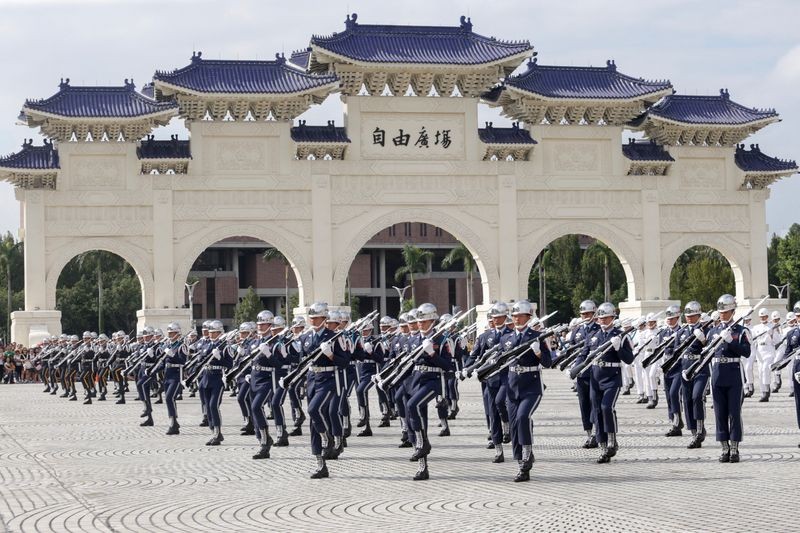By Nora Ma
Questions
Who changes the meaning of an architectural site ? How does a structure acquire a new meaning or significance? Who initiates protest, and how is protest involved in changing meaning?
Discussion
During and after the Chinese Civil War, the Nationalist Kuomintang Party moved to Taiwan in order to recoup its losses to the Chinese Communist Party, imposing martial law in Taiwan for four decades before its first fair and free election. Taiwan only began to officially liberalize as part of a project of “Taiwanization” after the end of martial law in 1987, assumption of power by Lee Tung Hui in 1988, and the death of Chiang Ching-Kuo, which occurred in the same year. The Chiang Kai-Shek Memorial Hall is a structure in Taipei that was created to commemorate the generalissimo’s death. The Memorial Square consists of the Memorial Hall and is flanked by two performance halls. In 1990, at the Memorial Square, a number of NTU students, Democratic Progressive Party members, and other political activists protested against government resistance to political liberalization. The event was named the “Wild Lily student movement” or “March student movement.” This literature review will focus on the Chiang Kai-Shek Memorial Hall, its different meanings in collective memory, and the influence of the Wild Lily/March student movement on understanding the space.
Mark Matten analyzes the significance of the Chiang Kai-Shek Memorial Hall in Taipei by demonstrating its status as a “focal point of identity” as a “symbolic” physical structure, introducing an initial theoretical framework to understand the space (53). He argues that the hall is a “contested space,” so different groups with various “agendas” interpret the space divergently based on their own experiences and identities (51). He follows with a historical examination of how Chiang has been depicted and the attitudes toward his death. Marten concludes by arguing that Chiang was part of “communicative memory,” but was never fully “objectified and transmitted in the institutionalized heritage… of society” (85). Chiang was a part “communicative memory” in that he existed in everyday terms, but because society lacked a “social consensus,” the idea of Chiang was never solidified in long-term “cultural memory” (85). Matten attributes this to the “profound generational change of the 1990s” and a “growing Taiwanese identity” (85). While Matten does not directly attribute these changes to the White Lily Movement, it nonetheless historically played a pivotal role in demands for new understandings of old KMT rules and “ideological truths” (85).
In relation to this understanding of how the politically and culturally laden meanings of the square change based on identity, Taylor adds that the movement of “de-Chiang-ification” of spaces in Taipei was a response to the “monopolization” of space by the KMT (188). Although Taylor mainly focused on the DPP’s removal of the influence of Chiang, the application of these concepts to the memorial is important. Taylor argues that during the period after his death, Chiang’s “personality cult” was important in reshaping the Taiwanese landscape (182). However, long after the death of Chiang and the end of martial law, the DPP is attempting to remove the monopoly of Chiang’s name on spaces, “returning” those spaces “to the people” (188). This can be directly applied in understanding the reclamation of the space during the March Movement: not only were students able to redefine the square to represent democratization, as Musgrove will argue, but they also present the space back to the public with a different meaning than it was initially constructed to convey.
Following Matten, Musgrove’s Taking Back Space focuses on the Wild Lily movement, asserting that the square originally represented KMT power, but then transitioned into a representation of democracy and pluralism through protest. Initially, after the death of Chiang Kai-Shek, the memorial built for him adopted a specific lens of “Chinese aesthetics” designed for large scale “celebrations of [the KMT] state” that ignored local architectural considerations (Musgrove, 302-304). The space, which consisted of the Memorial Hall, two music venues flanking each side, and a large park, was usually used for commemorating Chiang and for other Chinese festivals, “ritualizing” the space and “prescrib[ing] public behavior” (Musgrove, 306). However, many mourned at the site after hearing news about Tiananmen. The activism of Taiwanese opposing the actions of the CCP government regarding Tiananmen changed the nature of the space, making it “a space for revering democracy in particular,” priming the square for the Wild Lily Movement that would demand institutional changes within Taiwan’s National Assembly and the KMT’s grasp on power (Musgrove, 310). By then, in 1990, after the Wild Lily student movement, the social memory of the square had already rewritten its original use as a memorial for a Nationalist leader, signaling a shift towards democratic values in light of the Tiananmen Square Massacre. The memorial itself became a contested space with differing memories and interpretations based on both experience and sociopolitical views.

Figure 3: Protestors at Chiang Kai Shek Memorial Square, Cai, Mingde.
In Wright’s chapter, “Taiwan: Resisting Control of Campus and Polity,”she first explores how students became involved in activism, establishing “provocative student journalism” and “pro-reform groups” in response to KMT liberalization (113). She follows this article by explaining how the Wild Lily movement differed from Tiananmen Square in “Student Mobilization and Organization in Taiwan: March 1990.” This exploration is important in the literature due to the parallels between Tiananmen Square and the Wild Lily movement. Not only were the political symbolisms of both squares similar in their late-1980s significance, but both squares were also filled with students protesting against slowly liberalizing governments. As considered in the articles above, Taiwanese mourners of the Tiananmen massacre had filled Memorial Square just a year prior to commemorate those killed in 1989. Wright notes that the new administration of Lee Tung Hui explicitly told policemen to avoid violence against students at all costs, dragging DPP Chair Huang Hsin-Chih out of the square but peacefully addressing student protestors (127). She states that the lighter treatment may have been a result of student reluctance to affiliate themselves with the DPP (127). Wright ultimately argues that dissimilar mobilizations and relationships between students, party members, and government led to different outcomes in the two cases. Although Wright herself does not claim that Tiananmen was of direct significance to the Lee administration’s response, the fresh memory and striking similarities between the events may have contributed to the divergent results.
While there is an abundance of literature surrounding the construction of the memorial and the Wild Lily Movement, few sources were able to address the impact of the student movement on the understanding of the space itself, as Musgrove had done. The literature in English lacks direct evaluations of the connection between memory, protest, and the built environment, addressing each separately. These sources, however, clearly demonstrate the changing understandings of the square over time depending on collective memory and identity, despite its initial role as a symbol of Chiang and Nationalist primacy.
Sources
Musgrove, Charles D. “Taking Back Space: The Chiang Kai-Shek Memorial Hall and Taiwan’s Democratization.” Twentieth-Century China, vol. 42, no. 3, Oct. 2017, pp. 297–316. Project MUSE, doi:10.1353/tcc.2017.0025.
Matten, Marc Andre. “The Chiang Kai-Shek Memorial Hall in Taipei: A Place of Contested Memory.” Places of Memory in Modern China: History, Politics, and Identity, BRILL, 2012.
Wright, Teresa. “Taiwan: Resisting Control of Campus and Polity.” Student Activism in Asia: Between Protest and Powerlessness, edited by Meredith L. Weiss and Edward Aspinall, University of Minnesota Press, Minneapolis; London, 2012, pp. 101–124. JSTOR, www.jstor.org/stable/10.5749/j.ctttv18p.9. Accessed 28 Apr. 2020.
Wright, Teresa. The Perils of Protest: State Repression and Student Activism in China and Taiwan. University of Hawai’i Press, 2001. JSTOR, JSTOR, https://www.jstor.org/stable/j.ctt6wqjgg.
Taylor, Jeremy E. “Qujianghua: Disposing of and Re-Appraising the Remnants of Chiang Kai-Shek’s Reign on Taiwan.” Journal of Contemporary History, vol. 45, no. 1, 2010, pp. 181–96. JSTOR.




